
On the northwestern edge of Guatemala in an area known as the Petén, Marcello A. Canuto, archaeologist and new director of Tulane’s Middle American Research Institute, works with a team of academics, locals, and students to excavate a recently discovered site dating to the Preclassic period of Maya civilization. Led by Canuto, the group was awarded a $12,000 Waitt Foundation grant from the National Geographic Society. Waitt Grants are awarded “for exploratory fieldwork that holds promise for new breakthroughs in the natural and social sciences .” The grant supports Canuto’s research specific to the El Achiotal site.
Built on a ridge deep within the unexplored jungles of the Petén region, El Achiotal is one of at least a dozen archeological sites being investigated by the La Corona Regional Archaeological Project (PRALC). In the 1960’s, this previously inaccessible region was subject to looting. The pilferer’s actions revealed sculpted monuments and altars of formerly unknown Maya centers. “What makes El Achiotal special from the surrounding sites,” notes Canuto, “are signs that it may be at least 700 years older than the others, but is still highly developed.” One discovery that has led to this theory, and may help uncover the site’s true date and level of social development, is a unique mural found within a tunnel carved out by the looters. “The mural has a style dissimilar to what you see in other Maya murals of the same time period,” says Canuto. “Many Preclassic Maya murals feature an almost calligraphic style of painting, whereas the red painted mural from El Achiotal, however, is framed by more geometric or rectangular designs.
An additional clue to the site’s date and advanced organization may include its geographic orientation. “The buildings of El Achiotal are organized along a north-south axis which is distinct from the more common east-west orientations of its Preclassic contemporaries,” Canuto says. More evidence, however, through archeological digs and climate studies still needs to be conducted to prove anything conclusive.
Canuto is collaborating on the project with the Wildlife Conservation Society as well as the Guatemalan Government. The Waitt Grant has helped the members PRALC to map out sites, conduct test excavations, clear looters trenches, and properly record the exposed mural. Their archeological work will continue into the next dry season and Canuto will return to the site in March. With wildfires constantly burning just west of the region, Canuto stresses that “we have to work fast.”

